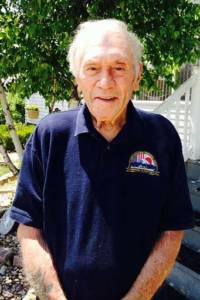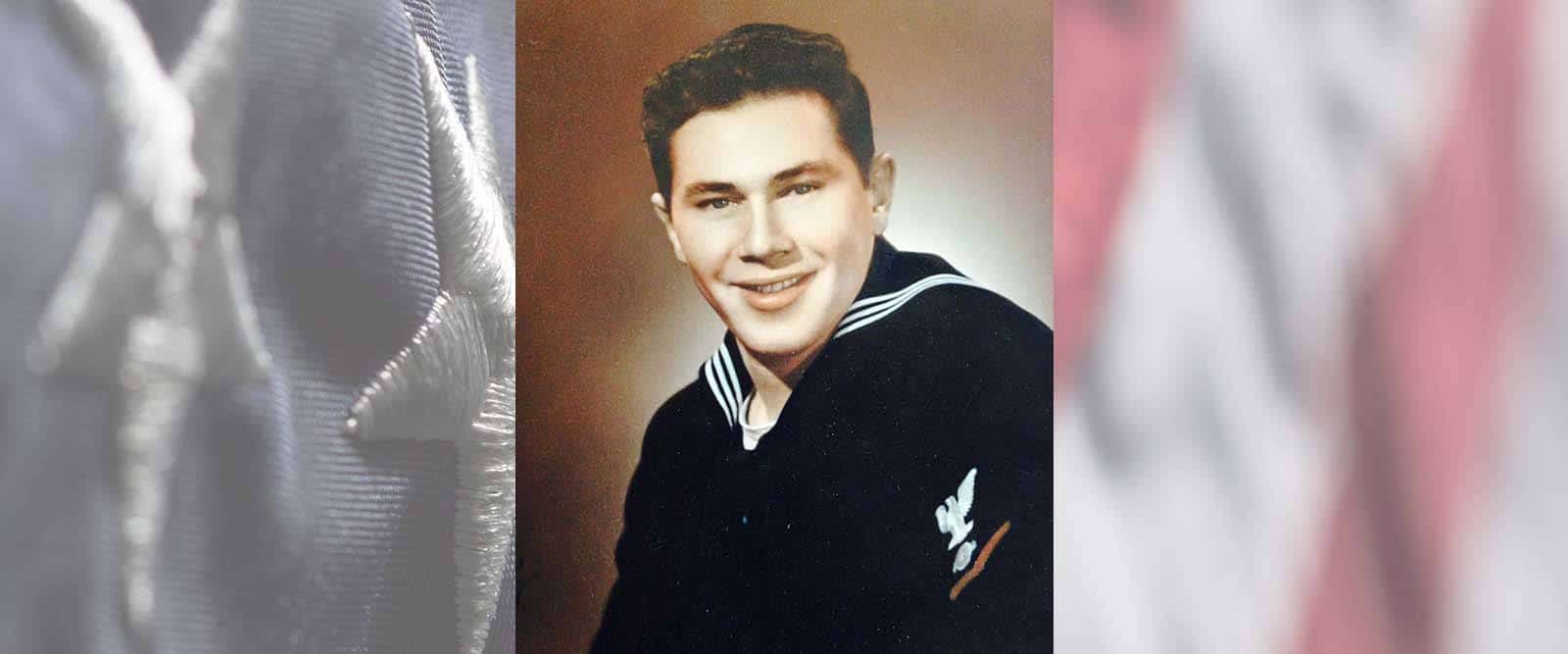U.S. Navy Korean War Frankfort, IL Flight date: 07/12/17
By Nancy Angel, Honor Flight Chicago Veteran Interview Volunteer
When Raymond “Bud” Wirth was 18 years old, he, his buddy Richard “Red” Cotter (who lived two doors down) and their other buddy Jimmy Shaughnessy (who lived two doors the opposite direction), decided to join the Navy. So on October 16, 1950, they went to the recruitment office in Cicero and enlisted. Soon they were off to Great Lakes for basic training. Their basic training was scheduled to last 12 weeks, but the Navy needed new recruits overseas, so their training was abbreviated to 10 weeks. They were given their orders and put on a troop train to Treasure Island Naval Station in San Francisco Bay. While traveling to California, Bud and Red, who had known each other since they were four years old, were surprised to learn that they had been assigned to the same ship, The USS Valley Forge. Bud remembers that since he was about 10 months older than Red, Red’s mom told him, “You’re older, so you take care of Richie.”
From Treasure Island, the men were taken to an ammunition dump about 3 miles away, where they boarded an ammunition ship, the Virgo, with three hulls full of ammunition. The Virgo transported them to Sasebo, Japan, where they boarded a tanker and went out to sea. Once out at sea, the aircraft carrier USS Valley Forge came alongside them and the announcement was made, “All recruits, line up!” The recruits were to reach the USS Valley Forge via a high line strung between the two vessels, strapped into a harness. Everyone wanted to be the first to go across, but the chief said he was going first. The weather was bad and the water rough, so it was difficult to keep the boats stationary. The boats moved a little closer together, causing some slack in the line and causing the chief to be dipped in the water as he was being pulled across. After seeing this, the new recruits weren’t so eager to be the first across. Eventually they were all brought over, including Bud and his friend Red, who would spend the next 39 months aboard the USS Valley Forge.

The ship’s home base was Yokosuka, Japan where they patrolled Wonsan Harbor. The USS Valley Forge supported air operations against the advancing Chinese and North Korean forces by launching planes to support ground troops near the 38th parallel. The planes also bombed North Korean trains carrying supplies, in order to prevent the supplies and ammunition from reaching the enemy front lines. Bud’s role as a boiler tender and fireman were critical to these operations as the eight boilers on the ship all had to be fired up properly in order for the ship to reach the speed of 31 knots required for flight quarters, or the launching of planes. The USS Valley Forge carried AD Dive-bombers (A1 Skyraiders), F4U Corsairs and F9F Panther Jets. When the planes were not being launched, the ship traveled at a slower speed and not all of the boilers were lit. Typically some of the boilers were shut down at night. However, sometimes they called for night quarters or a night launch. This meant that while the men were sleeping, all of the lights were turned on in the engineers’ quarters and they heard “Hit the deck; we’re going to light off!” This meant they all had to jump up and head to the boiler room, because all eight of the boilers needed to be lit to get the ship up to speed for a night launch, which required all hands on deck.
Another role of the USS Valley Forge was to pick up downed pilots in Wonsan Harbor. The pilots were instructed that if their planes were hit and disabled, they should head for Wonsan Harbor, where they would be picked up. Bud says that they had one of the best helicopter pilots in the Navy on their ship to go rescue the pilots from the harbor. There were also frogmen who were lowered down from the helicopters to assist the pilots when they were unable to get out of their cockpits on their own. Bud recalls how young some of these pilots were, and how he’d see them climbing into a plane for another mission just 4 or 5 hours after being rescued from the harbor.
As with most jobs, the new recruits had to pay their dues while earning their stripes. In the first year or so on board, Bud was an apprentice, which came with some less than desirable duties and responsibilities. One of these was mess duty, where he had to work shifts in the mess hall on the steam table. Another was smoke watch. This entailed climbing up a very tall, very narrow ladder to the crow’s nest, a small platform enclosed by a small rail which was located high enough up to see the tops of the smokestacks of all eight boilers. The man on smoke watch had a headset and would radio down to the boiler room if the color and type of smoke coming out of the any of the smokestacks was indicating less than ideal boiler operation. He would report “too black” or “too white” and the smokestack number to the boiler room, so they’d know how to adjust the air to the boiler. It was scary enough being up that high on such a small platform, but even more nerve-wracking when planes were coming in for a landing. Bud said he always hoped that if an incoming plane was waved off by the flagman to circle around again, they’d head away from the crow’s nest and not toward it when he was sitting up there! He remembers that some of the airplanes seemed to pass pretty close to the tower. Bud was glad when he made petty officer and didn’t have to take smoke watch any more.
After Bud had been on the ship for a few years, the USS Valley Forge was being sent to the Mediterranean. Because Bud had less than 30 days left on his tour of duty, he would not be joining them. He remained on the ship as they travelled through the Panama Canal (they didn’t quite fit, so lost two gun turrets going through the canal) and back to Norfolk, Virginia, where both Bud and his friend Red were dropped off. Their last few weeks in the Navy were spent assigned to shore patrol in Norfolk, which Bud recalls consisted mostly of walking around, armed with handcuffs and a nightstick, breaking up bar fights. When they had completed their four years of service in August of 1954, Bud and Red took a train from Norfolk home to Chicago. Bud says that his time in the Navy was interesting and enjoyable – he felt it was a good experience. He continues to be in contact with his pal Red Cotter, and attends the annual ship’s reunions as often as he can.
A couple of months after returning home, Bud married Loretta, whom he’d dated before joining the Navy and who had written him faithfully while he was gone. They had three children, two girls and a boy, and now grandchildren and great-grandchildren. They are expecting their first great-great-grandchild! Two of their grandsons followed in their grandfather’s footsteps in service to their country: one is in the Coast Guard in Boston, and one, his namesake, Raymond Wirth, is in his 21st year in the Navy, currently stationed in Yokosuka, Japan, just like his grandfather!
Bud worked for 40 years as a brick and stone mason. He misses the work and enjoys seeing the fruits of his labors when he attends a couple of local churches that he did stone work on. Just as he was once in service to our country, he still keeps busy in service to the community by volunteering with the local police as a Senior on Patrol, collecting and delivering donations to the veteran’s home, and assisting neighbors with chores.
Thank you Raymond for your service and sacrifice during the Korean War. Enjoy your well-deserved day of honor in Washington, D.C.



